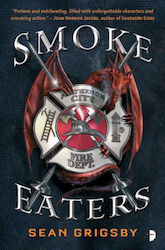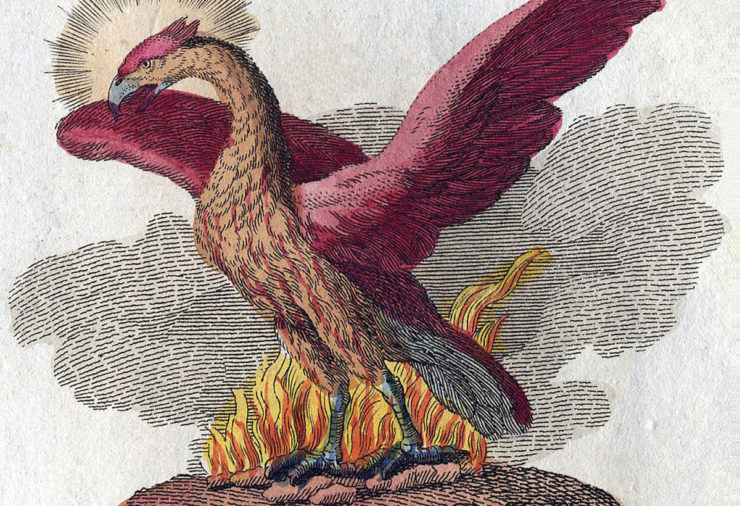And you thought dragons were tough.
In my previous article, A Firefighter’s Guide to Fighting Dragons, I discussed how real-life smoke eaters could battle the ultimate fantasy archetype: the dragon. But that was just the basics, rookie stuff. I didn’t have time to get into the stranger types of scaly beasts, who use steam, ice, and ink instead of fire. Nor did I go into the specific tactics needed to take down a whole other kind of winged, fiery monster.
In the second book of the series, Ash Kickers, smoke eater Tamerica Williams has to combat dragons of all hazards as well as an honest-to-goodness, rise-from-the-ashes phoenix, and this fire bird brings a myriad of problems. For one, it drives the dragons crazy, turning them into rabid juggernauts that follow wherever the phoenix leads. It eats dragons, sure, but each meal increases the phoenix’s size and level of radiant heat. The bird is made almost entirely of fire, and its heat makes dragon breath feel like an ice cream cone to the face. Not even the smoke eaters can tolerate these flames. On top of all of this, if you’re fortunate enough to slay the phoenix it’ll just rise again, hotter, stronger, and meaner than before.
I’ll be addressing this type of phoenix for the rest of the article, so I won’t tip my hat to, say, the variation in the Supernatural television series, whose ashes Sam and Dean travel to the old west to collect.
I’d wondered how fast the Winchester Impala had to go to jump the shark. I guess, like a DeLorean, it was 88 miles per hour.
So, looking at the enemy we’re facing, a few things occur to me. For one, we can look at the phoenix as a high-risk, low frequency type of event—a once-in-a-career fire, the kind of legendary blaze they’ll be discussing around the firehouse kitchen table for generations to come. Sounds cool, but these are the types of events that can also go terribly wrong. The fight ahead can just as likely be used as a classroom example of what not to do. Keeping calm, remembering your training, and remaining flexible to the demands of the job are what will keep you alive.
Next, you might have wondered—because the phoenix eats dragons—why we don’t just let the fire bird kill off a ton of scalies and then fly somewhere else, kind of like how firefighters standby while a gas leak burns off. However, unlike a burning propane tank, a phoenix is mobile and will scorch countless people and structures on its way out of town—if it ever leaves—and a tank of gas, cooled so it doesn’t cause a BLEVE (Boiling Liquid Expanding Vapor Explosion), eventually runs out of fuel.
We’ve got to hit the phoenix fast and hard. This is how I suggest we do it:
1. Water, Foam, and Lots of It
As always, rescuing people comes first, but after that, we’re going into massive defensive operations, what some in the fire service call “surround and drown.” The phoenix is giving off a lot of heat and that’s going to take a lot of water to cool. How much? Firefighters have a formula to calculate fire flow, i.e. how much wet stuff to put on the red stuff.
Let’s say we have a 30’ x 50’ building that’s 25 % involved (on fire). That means we have a 1500 square foot space, we divide by 3 to get 500. Given the amount of fire, we use the equation 500 x 0.25 to get 125, which means we’d need 125 gallons per minute to extinguish this fire, something a single handline could easily do.
The phoenix is not this simple.
It’s going to take the whole fleet, and the assistance of neighboring cities’ fire crews to battle this thing. I suggest multiple aerial ladder trucks, fully extended, to surround the phoenix while engines provide each truck with the water to hit the fire bird from every angle. We’ll need as many master streams as we can get, which includes deck guns fixed to the tops of fire engines, as well as portable monitors that work the same way. If we have foam to use, we’re going to go through all of it.
2. Be Aggressive, Yet Defensive
The phoenix is going to be pissed.
Obviously we’re going to need the same tools in hand as if we were slaying a dragon, but implementing them is time sensitive. Our pike poles and axes will likely melt before we get close enough to deal a fatal blow, so we’re going to rely on water and foam to cool the bird enough to put our weapons to effective use. Knowing when to attack and when to stay back is the name of the game here. We want to strike quickly with water and then put an end to the problem before it becomes an even bigger conundrum. But remember, even with the fire under control, the phoenix still has talons and a beak that could snap a steel beam in half. It’s still a huge, angry bird. If you’ve never known anyone who’s kept chickens, well I can tell you birds are meaner than hell. If you’re cautious but swift to act, you should end up with a pile of Tweety ashes.
3. Call in the Experts
Certain fire crews are specialized and have a bit more knowledge when it comes to unique emergencies. I’d definitely call a Haz-Mat unit to the scene to collect the phoenix ashes. They will have specific gear and tools to safely remove the hazardous debris. We’ll do our part in helping them, by not dirtying up the scene. Just like with an arson investigation, we won’t trudge through the ashes or get in the way of others doing their job. Grab a cup of ice water and park your behind on the front bumper.
4. Rekindle
Sometimes, just when you thought the job was done, you’re rudely corrected by an alarm blaring in the middle of the night and you have to return to the scene of a house fire you just put out. For whatever reason, on-scene crews, who’d soaked every inch of the structure, might have missed some smoldering embers trapped inside a wall joist. Maybe an arsonist returned to finish the place off. Whatever the case, rekindles (fires restarting) happen, and no matter how tired you are from fighting the blaze the first time, you’re going to have to dig deep, pull on your sweat-soaked and smoky turnouts, and ride out again.
Buy the Book


Smoke Eaters
The phoenix has a well-documented history of rekindling. We’ll have to be prepared to fight it more than once. This calls for us to be in shape not only physically, but even more so mentally. First responders are at a high risk of suffering from PTSD, depression, and burnout. Our first priority is to ourselves and our fellow smoke eaters. A mental health program should be in place well before any phoenix emerges the light up the night sky.
Will we ever find a way to extinguish the phoenix for good?
Fahrenheit 451 imagined a world where firefighters no longer had fires to fight, but what the future has shown is that fires haven’t gone away. Though their occurrences are less frequent, fires have become more complicated and dangerous, and not just because they’re hotter. The chemicals that fill a house on fire would make Walter White blush. The job of a firefighter has transformed over the years to meet the needs of the public they serve.
I don’t know if the phoenix ashes will remain cold or, to put it more concretely, if there will always be fires to put out, but I’ll quote the last few lines from Smoke Eaters, and let Cole Brannigan answer that question:
“Well, I’m saying right now, there won’t be an end to it. There will always be dragons. You can either run, and eventually burn, or you can take up your lance and do what you were born for.
“I’ve made my choice. Sink or swim.”
Originally published July 2019.
Sean Grigsby is a professional firefighter in central Arkansas, where he writes about lasers, aliens, and guitar battles with the Devil when he’s not fighting dragons. He grew up on Goosebumps books in Memphis, Tennessee, and hosts the Cosmic Dragon podcast. His first novel is Smoke Eaters. Ash Kickers will be available on July 9 from Angry Robot Books










